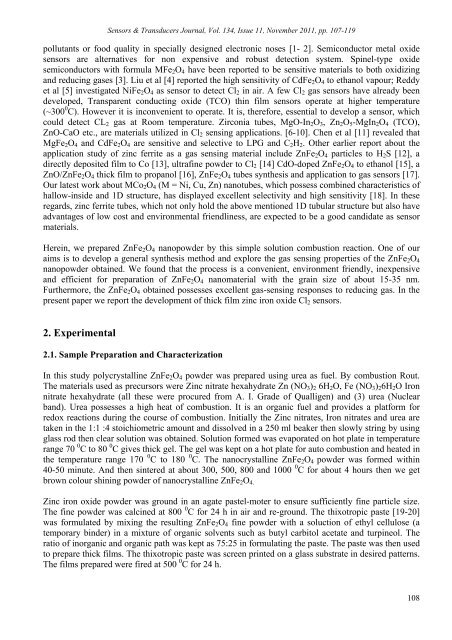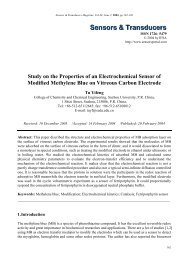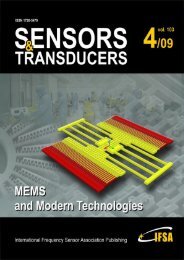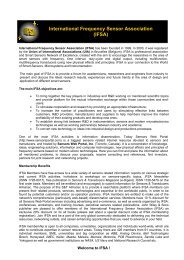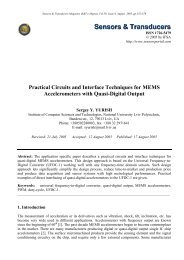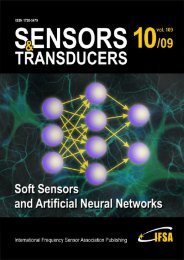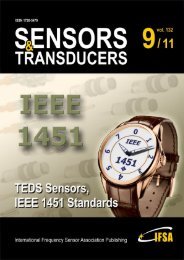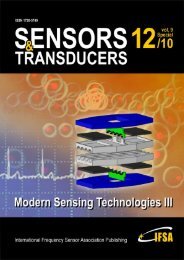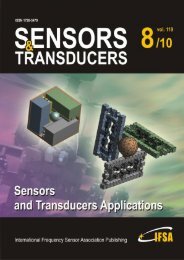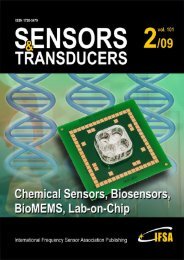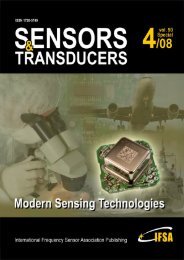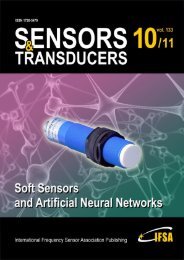Nanostructured Spinel ZnFe2O4 for the Detection of ... - ResearchGate
Nanostructured Spinel ZnFe2O4 for the Detection of ... - ResearchGate
Nanostructured Spinel ZnFe2O4 for the Detection of ... - ResearchGate
- No tags were found...
Create successful ePaper yourself
Turn your PDF publications into a flip-book with our unique Google optimized e-Paper software.
Sensors & Transducers Journal, Vol. 134, Issue 11, November 2011, pp. 107-119pollutants or food quality in specially designed electronic noses [1- 2]. Semiconductor metal oxidesensors are alternatives <strong>for</strong> non expensive and robust detection system. <strong>Spinel</strong>-type oxidesemiconductors with <strong>for</strong>mula MFe 2 O 4 have been reported to be sensitive materials to both oxidizingand reducing gases [3]. Liu et al [4] reported <strong>the</strong> high sensitivity <strong>of</strong> CdFe 2 O 4 to ethanol vapour; Reddyet al [5] investigated NiFe 2 O 4 as sensor to detect Cl 2 in air. A few Cl 2 gas sensors have already beendeveloped, Transparent conducting oxide (TCO) thin film sensors operate at higher temperature(~300 0 C). However it is inconvenient to operate. It is, <strong>the</strong>re<strong>for</strong>e, essential to develop a sensor, whichcould detect CL 2 gas at Room temperature. Zirconia tubes, MgO-In 2 O 3 , Zn 2 O 5 -MgIn 2 O 4 (TCO),ZnO-CaO etc., are materials utilized in Cl 2 sensing applications. [6-10]. Chen et al [11] revealed thatMgFe 2 O 4 and CdFe 2 O 4 are sensitive and selective to LPG and C 2 H 2 . O<strong>the</strong>r earlier report about <strong>the</strong>application study <strong>of</strong> zinc ferrite as a gas sensing material include ZnFe 2 O 4 particles to H 2 S [12], adirectly deposited film to Co [13], ultrafine powder to Cl 2 [14] CdO-doped ZnFe 2 O 4 to ethanol [15], aZnO/ZnFe 2 O 4 thick film to propanol [16], ZnFe 2 O 4 tubes syn<strong>the</strong>sis and application to gas sensors [17].Our latest work about MCo 2 O 4 (M = Ni, Cu, Zn) nanotubes, which possess combined characteristics <strong>of</strong>hallow-inside and 1D structure, has displayed excellent selectivity and high sensitivity [18]. In <strong>the</strong>seregards, zinc ferrite tubes, which not only hold <strong>the</strong> above mentioned 1D tubular structure but also haveadvantages <strong>of</strong> low cost and environmental friendliness, are expected to be a good candidate as sensormaterials.Herein, we prepared ZnFe 2 O 4 nanopowder by this simple solution combustion reaction. One <strong>of</strong> ouraims is to develop a general syn<strong>the</strong>sis method and explore <strong>the</strong> gas sensing properties <strong>of</strong> <strong>the</strong> ZnFe 2 O 4nanopowder obtained. We found that <strong>the</strong> process is a convenient, environment friendly, inexpensiveand efficient <strong>for</strong> preparation <strong>of</strong> ZnFe 2 O 4 nanomaterial with <strong>the</strong> grain size <strong>of</strong> about 15-35 nm.Fur<strong>the</strong>rmore, <strong>the</strong> ZnFe 2 O 4 obtained possesses excellent gas-sensing responses to reducing gas. In <strong>the</strong>present paper we report <strong>the</strong> development <strong>of</strong> thick film zinc iron oxide Cl 2 sensors.2. Experimental2.1. Sample Preparation and CharacterizationIn this study polycrystalline ZnFe 2 O 4 powder was prepared using urea as fuel. By combustion Rout.The materials used as precursors were Zinc nitrate hexahydrate Zn (NO 3 ) 2 6H 2 O, Fe (NO 3 ) 2 6H 2 O Ironnitrate hexahydrate (all <strong>the</strong>se were procured from A. I. Grade <strong>of</strong> Qualligen) and (3) urea (Nuclearband). Urea possesses a high heat <strong>of</strong> combustion. It is an organic fuel and provides a plat<strong>for</strong>m <strong>for</strong>redox reactions during <strong>the</strong> course <strong>of</strong> combustion. Initially <strong>the</strong> Zinc nitrates, Iron nitrates and urea aretaken in <strong>the</strong> 1:1 :4 stoichiometric amount and dissolved in a 250 ml beaker <strong>the</strong>n slowly string by usingglass rod <strong>the</strong>n clear solution was obtained. Solution <strong>for</strong>med was evaporated on hot plate in temperaturerange 70 0 C to 80 0 C gives thick gel. The gel was kept on a hot plate <strong>for</strong> auto combustion and heated in<strong>the</strong> temperature range 170 0 C to 180 0 C. The nanocrystalline ZnFe 2 O 4 powder was <strong>for</strong>med within40-50 minute. And <strong>the</strong>n sintered at about 300, 500, 800 and 1000 0 C <strong>for</strong> about 4 hours <strong>the</strong>n we getbrown colour shining powder <strong>of</strong> nanocrystalline ZnFe 2 O 4.Zinc iron oxide powder was ground in an agate pastel-moter to ensure sufficiently fine particle size.The fine powder was calcined at 800 0 C <strong>for</strong> 24 h in air and re-ground. The thixotropic paste [19-20]was <strong>for</strong>mulated by mixing <strong>the</strong> resulting ZnFe 2 O 4 fine powder with a soluction <strong>of</strong> ethyl cellulose (atemporary binder) in a mixture <strong>of</strong> organic solvents such as butyl carbitol acetate and turpineol. Theratio <strong>of</strong> inorganic and organic path was kept as 75:25 in <strong>for</strong>mulating <strong>the</strong> paste. The paste was <strong>the</strong>n usedto prepare thick films. The thixotropic paste was screen printed on a glass substrate in desired patterns.The films prepared were fired at 500 0 C <strong>for</strong> 24 h.108


